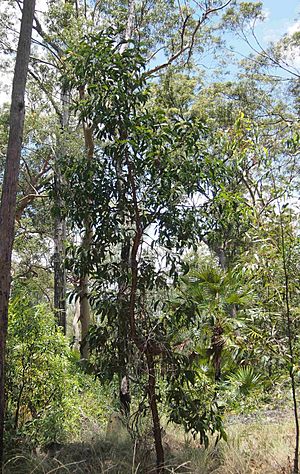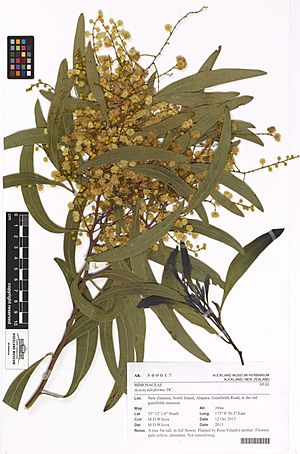Broad-leaved hickory facts for kids
Quick facts for kids Broad-leaved hickory |
|
|---|---|
 |
|
| A. falciformis habit | |
| Scientific classification | |
| Genus: |
Acacia
|
| Species: |
falciformis
|
 |
|
| Occurrence data from AVH | |
The Broad-leaved hickory, also known as hickory wattle or mountain hickory, is a type of shrub or small tree. Its scientific name is Acacia falciformis. This plant belongs to the Acacia family, which includes many types of wattles. It grows only in eastern Australia.
What Does Broad-leaved Hickory Look Like?
This plant can be a shrub or a small tree. It usually grows between 2 and 10 meters (about 6 to 33 feet) tall. Its bark is grey to black and can be cracked or deeply grooved. The young branches are smooth and often have angles.
The leaves of the Broad-leaved hickory are special. They are called phyllodes. These are flattened leaf stalks that look and act like leaves. They are mostly green and have a long, oval shape. Some are straight, while others are slightly curved like a sickle. These smooth phyllodes are 8 to 22 centimeters (about 3 to 8.5 inches) long. They are also 12 to 40 millimeters (about 0.5 to 1.5 inches) wide. Each phyllode has one main vein that stands out.
The plant blooms from July to October. Most often, it flowers in August and September. Its flowers grow in round clusters, usually 5 to 18 clusters together. Each flower cluster is about 5 to 6 millimeters (0.2 inches) across. They contain 13 to 25 small flowers. These flowers are pale yellow to cream-colored, and sometimes bright yellow.
After the flowers, flat, leathery, brown seed pods grow. These pods are usually straight but can be a little curved. They are 5 to 13 centimeters (about 2 to 5 inches) long and 12 to 25 millimeters (about 0.5 to 1 inch) wide. Inside the pods are shiny, black seeds. The seeds are oblong or oval-shaped and are 5.5 to 7 millimeters (about 0.2 to 0.3 inches) long.
Naming and Family Tree
The Broad-leaved hickory was first officially described in 1825. A botanist named Augustin Pyramus de Candolle gave it its scientific name. The name falciformis refers to the shape of its phyllodes. Falcate means curved like a sickle, which describes the shape of some of its leaves.
This plant looks similar to other wattle species. These include Acacia penninervis and Acacia obliquinervia. It can also mix with Acacia bancroftiorum to form hybrid plants.
Where Does It Grow?
Acacia falciformis is found all along the east coast of Australia. You can see it in the states of Queensland, New South Wales, and Victoria. It grows in areas near the coast. It also grows further inland, over the Great Dividing Range mountains.
This shrub likes many different places. It can be found on moist, rocky slopes and in gullies. It also grows along watercourses. It often lives in sclerophyll forests or woodlands. These are types of forests with hard-leaved plants. The plant's range stretches from Traralgon in the south to the Atherton Tableland in the north. Most of these plants are found south of Warwick, Queensland.


